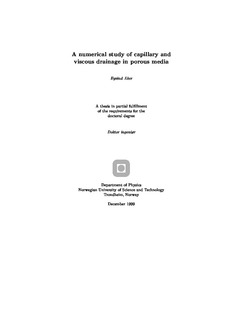| dc.contributor.author | Aker, Eyvind | nb_NO |
| dc.date.accessioned | 2014-12-19T13:16:03Z | |
| dc.date.available | 2014-12-19T13:16:03Z | |
| dc.date.created | 2008-03-06 | nb_NO |
| dc.date.issued | 1999 | nb_NO |
| dc.identifier | 123765 | nb_NO |
| dc.identifier.isbn | 82-7984-012-5 | nb_NO |
| dc.identifier.uri | http://hdl.handle.net/11250/246183 | |
| dc.description.abstract | This work concentrates on the flow properties when one fluid displaces another fluid in a network of pores and throats. We consider the scale where individual pores enter the description and we use a network model to simulate the displacement process. The network model, representing the pores and the throats in the porous media, consists of a square lattice of cylindrical tubes.
Network models together with experimental work on real porous systems, have been successful in describing important properties of the fluid-fluid displacement. In this thesis we study the interplay between the pressure build up in the fluids and the displacement structure during drainage. Drainage is when a nonwetting fluid displaces a wetting fluid in porous media.
We have found that our network model properly describes the burst dynamics and the pressure buildup due to capillary and viscous forces in the displacements. With respect to the local capillary pressures of menisci in the network, we model the tubes as if they were hourglass shaped. This has shown to make the model closer to the dynamics of real displacements in porous media. There is also good correspondence between the simulated temporal evolution of the fluid pressures and earlier results from experiments and simulations in slow drainage.
We have used the network model to study the stabilization mechanisms when a stable front develops. We consider two-dimensional horizontal displacements where the viscous forces stabilize the front and gravity might be neglected. In particular, we have calculated the pressure difference between the fluids, that is the capillary pressure, along the invasion front. We find that the capillary pressure between two points along the front varies almost linearly as function of height separation in the directions of the displacement, This is quite surprising since the viscous force field is expected to be inhomogeneous due to trapping of wetting fluid and to the fractal displacement structure.
We present an alternative view on the displacement process based on the observation that nonwetting fluid flows in separate strands (paths) along the front were wetting fluid is displaced. We show that the strands are loopless because wetting fluid may be trapped in single tubes surrounded by nonwetting fluids. By using the alternative view we, present arguments about the pressure behaviour in the front. The arguments are supported by numerical results, and we also show that they might influence the scaling relation between the front width and the injection rate. As a consequence of our findings, we conclude that earlier suggested theories which do not include the effect of nonwetting fluid flowing in strands, are nor compatible with drainage when strands dominate the displacement process. | nb_NO |
| dc.language | eng | nb_NO |
| dc.publisher | Fakultet for naturvitenskap og teknologi | nb_NO |
| dc.relation.ispartofseries | Dr. ingeniøravhandling, 0809-103X; 1999:131 | nb_NO |
| dc.title | A Numerical Study of Capillary and Viscous Drainage in Porous Media | nb_NO |
| dc.type | Doctoral thesis | nb_NO |
| dc.contributor.department | Norges teknisk-naturvitenskapelige universitet, Fakultet for naturvitenskap og teknologi, Institutt for fysikk | nb_NO |
| dc.description.degree | dr.ing. | nb_NO |
| dc.description.degree | dr.ing. | en_GB |
